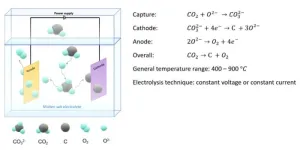(Press-News.org) The opioid crisis continues to pose a grave public health concern, with synthetic opioids such as fentanyl posing a major risk for development of addiction and death due to overdose. In a ground-breaking development, a recent study by the research group led by Prof. Ami Citri at the Hebrew University of Jerusalem's Edmond and Lily Safra Center for Brain Sciences has unveiled crucial insights into the brain's potential ability to regulate the urge to consume fentanyl. This discovery offers a glimmer of hope in the ongoing battle against opioid addiction.
The study, titled "Claustral neurons projecting to frontal cortex restrict opioid consumption" and published in the journal Current Biology, focused on claustral neurons, a specific type of brain cells, and their role in fentanyl consumption. The researchers discovered that claustral neurons exhibited distinctive patterns of activity during consumption of fentanyl. Manipulating these neurons allowed the researchers to modulate the amount of fentanyl consumed, indicating their direct influence on opioid intake.
This study also introduced a novel method for studying opioid consumption, more closely mimicking the real-life conditions under which humans consume opioids. By enabling the exploration of how social interactions influence drug consumption, this technical advance is set to provide valuable insights, promoting the identification of treatments that will alleviate addiction.
The results of this study represent a significant advancement in combating opioid addiction, offering a ray of hope in the ongoing battle. Particularly noteworthy is the discovery that the claustrum acts as a regulator of fentanyl intake. When the claustrum is activated, it effectively reduces drug consumption, whereas its suppression leads to an escalation in drug intake. This crucial finding suggests that targeting claustral neurons holds promise for the future development of effective strategies aimed at mitigating opioid addiction in human patients. Work along these lines is currently underway in the lab.
Prof. Ami Citri, the lead investigator from the Hebrew University of Jerusalem, expressed enthusiasm about the study's potential implications, stating, "Our findings shed light on the intricate relationship between the brain and fentanyl consumption. Understanding the role of claustral neurons in regulating the urge to consume opioids offers a new avenue for interventions aimed at curbing addiction."
The study's outcomes carry significant implications for public health initiatives addressing the opioid crisis. By expanding our knowledge of the neural processes involved in addiction, researchers and healthcare professionals can work toward developing more effective prevention and treatment strategies.
This study represents a significant technical achievement in the field of neuroscience. Co-authored by Anna Terem who was recently awarded her PhD, and Yonatan Fatal, who initiated the project as a high-school student, the research demonstrates the potential to shape future therapeutic interventions and offers valuable insights into the mechanisms underlying the regulation of opioid consumption.
Moving forward, this study opens doors for further investigation into the claustrum's function in different stages and aspects of the addiction process. The results highlight the claustrum as a potential target for intervention in fentanyl addiction. Follow-up studies can explore drugs and substances that increase claustrum activity to determine their effectiveness in decreasing drug consumption and addiction. While more research is needed, the study's findings hold promise for preventing addiction and potentially helping individuals currently struggling with active addiction.
END
New study reveals brain's potential to regulate fentanyl consumption, offering hope in the fight against opioid addiction
Unveiling the brain's power: Study shows potential for regulating fentanyl consumption in battle against opioid addiction
2023-06-26
ELSE PRESS RELEASES FROM THIS DATE:
Supplemental Nutrition Assistance Program access and racial disparities in food insecurity
2023-06-26
About The Study: Racial disparities in food insecurity were found among low-income households that do not participate in Supplemental Nutrition Assistance Program (SNAP) but not among those that do, suggesting that access to SNAP should be improved. These results also highlight the need to examine the structural and systemic racism in food systems and in access to food assistance that may contribute to disparities.
Authors: Laura J. Samuel, Ph.D., R.N., of the Johns Hopkins School of Nursing in Baltimore, is the corresponding author.
To access the embargoed study: Visit our For The Media website at this link https://media.jamanetwork.com/
(doi:10.1001/jamanetworkopen.2023.20196)
Editor’s ...
Study of deep-sea corals reveals ocean currents have not fuelled rise in atmospheric carbon dioxide
2023-06-26
Pioneering analysis of deep-sea corals has overturned the idea that ocean currents contributed to increasing global levels of carbon dioxide in the air over the past 11,000 years.
The study, led by the University of Bristol in the UK and Nanjing University in China, examined historic deep-sea corals to shed intriguing new light on the history of ocean chemistry.
Understanding what has led to the pre-industrial rise in carbon dioxide (CO2) levels during the Holocene period, which dates back some 11,700 years to the present day, is a source of scientific debate. One theory suggests the increase in physical ...
Tuning T cell traits and functions with biomechanical materials
2023-06-26
By Benjamin Boettner
(Boston) — The successful campaign of adoptive T cell therapies, a type of immunotherapy in which immune T cells are collected from a patient, enhanced outside of the body, and reinfused back into the same patient, especially against blood cancers is well under way. But improving the ability to create patient-specific T cell populations with specific traits and functions could broaden clinicians’ repertoire of T cell therapies.
One way to approach this goal is to better understand how T cells’ traits and functions, including their cytotoxic effects on ...
New understanding of why kidney cancers become metastatic discovered by MD Anderson researchers
2023-06-26
HOUSTON ― Researchers at The University of Texas MD Anderson Cancer have engineered a new model of aggressive renal cell carcinoma (RCC), highlighting molecular targets and genomic events that trigger chromosomal instability and drive metastatic progression.
The study, published today in Nature Cancer, demonstrates that the loss of a cluster of interferon receptor (IFNR) genes plays a pivotal role in allowing cancer cells to become tolerant of chromosomal instability. This genomic feature may be used to help clinicians predict a tumor’s potential to become metastatic and treatment resistant.
Researchers led by Luigi Perelli, ...
Dry days trigger leaves to send a surprising growth signal telling roots to keep growing
2023-06-26
Scientists at the Sainsbury Laboratory Cambridge University (SLCU) have discovered a new molecular signalling pathway, triggered when leaves are exposed to low humidity, that ensures plant roots keep growing towards water.
In dry soil conditions, plants take action to try and conserve water by producing the drought stress hormone abscisic acid (ABA). For decades plant scientists thought that in response to dry soil, ABA was made in the roots and then transported to the leaves. In this root-to-shoot signalling pathway, ABA closes microscopic leaf pores, called stomata, to prevent water loss from leaves. In recent years, scientists ...
Study on rare antibodies hints at strategy tweaks that may future-proof COVID-19 vaccines
2023-06-26
New research examining how frequently our bodies produce broadly neutralizing antibodies (bnAbs) capable of thwarting a range of SARS-CoV-2 variants offers clues on the strategy tweaks that could potentially future-proof COVID-19 vaccines.
To counter invading viruses, our body deploys specific antibodies, among them the neutralizing kind targeting the receptor-binding domain (RBD) — the “Velcro hooks” used by pathogens to fasten onto our cells. As SARS-CoV-2 accumulates genetic mutations, new variants emerge donning sneaky disguises to outsmart our defenses. So-called bnAbs are elite neutralizing antibodies that can keep up ...
Overview of CO2 capture and electrolysis technology in molten salts: operational parameters and their effects
2023-06-26
Carbon dioxide capture, storage, and utilization have been widely researched to achieve CO2 zero emission and resolve climate change issues. Molten salt electrolysis is one promising method to simultaneously capture and convert CO2 into valuable carbon materials and oxygen with high current efficiencies, to provide a promisingly positive cash flow. However, this method still requires investigation for future scale-up applications. A team of scientists reviews the molten salt CO2 electrolysis’s ...
Researchers urge caution in gene editing early human embryos following findings that it could have unexpected and dangerous consequences Further research to refine gene editing technology is needed
2023-06-26
Copenhagen, Denmark: Scientists have discovered that the cells of early human embryos are often unable to repair damage to their DNA. The researchers say that this has important implications for the proposed use of gene editing techniques to remove serious inherited diseases from embryos, as well as for IVF in general.
Presenting the research to the 39th annual meeting of the European Society of Human Reproduction and Embryology (ESHRE) [1], Dr Nada Kubikova from the University of Oxford (UK), said: “Gene editing has the potential to correct defective genes, a process that usually involves first breaking and then ...
New sensor chip advances rapid, cost-effective disease diagnostics
2023-06-26
Media Inquiries to Laura Muntean, laura.muntean@ag.tamu.edu, 6012481891
Written by Gabe Saldana, 956-408-5040, gabe.saldana@ag.tamu.edu
Texas A&M AgriLife Research scientists and collaborators at Iowa State University have developed a sensor chip that can detect many disease pathogens with 10 times the sensitivity of currently available methods.
The chip also eliminates the need for chemical dye reagents typically used in the diagnostic process. The new technology shows promise for rapid, low-cost point-of-care diagnostic capabilities in plants, foods, animals and humans, including detecting foodborne pathogens, bird flu and COVID-19.
An ...
Opting to freeze eggs can help women have babies when they are older, but many do not use their frozen eggs
2023-06-26
Copenhagen, Denmark: More than 40% of women who chose to freeze their eggs in their 30s were able to have babies later in life when they returned to the fertility clinic, according to research presented today (Monday) at the 39th annual meeting of the European Society of Human Reproduction and Embryology (ESHRE) [1].
However, many of the women in the study who had frozen their eggs (known as elective oocyte cryopreservation) had not returned to the fertility clinic and many who did return chose fertility treatments that did not involve their frozen eggs.
The research was presented by Dr Ezgi Darici, a clinical fellow at the Centre for Reproductive Medicine at ...
LAST 30 PRESS RELEASES:
Structure of dopamine-releasing neurons relates to the type of circuits they form for smell-processing
Reducing social isolation protects the brain in later life
Keeping the heart healthy increases longevity even after cancer
Young adults commonly mix cannabis with nicotine and tobacco
Comprehensive review illuminates tau protein's dual nature in brain health, disease, and emerging psychiatric connections
Book prepares K-12 leaders for the next public health crisis
Storms in the Southern Ocean mitigates global warming
Seals on the move: Research reveals key data for offshore development and international ecology
Sports injuries sustained during your period might be more severe
World's first successful 2 Tbit/s free-space optical communication using small optical terminals mountable on satellites and HAPS
Can intimate relationships affect your heart? New study says ‘yes’
Scalable and healable gradient textiles for multi‑scenario radiative cooling via bicomponent blow spinning
Research shows informed traders never let a good climate crisis go to waste
Intelligent XGBoost framework enhances asphalt pavement skid resistance assessment
Dual-function biomaterials for postoperative osteosarcoma: Tumor suppression and bone regeneration
New framework reveals where transport emissions concentrate in Singapore
NTP-enhanced lattice oxygen activation in Ce-Co catalysts for low-temperature soot combustion
Synergistic interface engineering in Cu-Zn-Ce catalysts for efficient CO2 hydrogenation to methanol
COVID-19 leaves a lasting mark on the human brain
Scientists use ultrasound to soften and treat cancer tumors without damaging healthy tissue
Community swimming program for Black youth boosts skills, sense of belonging, study finds
Specific depressive symptoms in midlife linked to increased dementia risk
An ‘illuminating’ design sheds light on cholesterol
Who is more likely to get long COVID?
Study showcases resilience and rapid growth of “living rocks”
Naval Research Lab diver earns Office of Naval Research 2025 Sailor of the Year
New Mayo-led study establishes practical definition for rapidly progressive dementia
Fossil fuel industry’s “climate false solutions” reinforce its power and aggravate environmental injustice
Researchers reveal bias in a widely used measure of algorithm performance
Alcohol causes cancer. A study from IOCB Prague confirms damage to DNA and shows how cells defend against it
[Press-News.org] New study reveals brain's potential to regulate fentanyl consumption, offering hope in the fight against opioid addictionUnveiling the brain's power: Study shows potential for regulating fentanyl consumption in battle against opioid addiction



